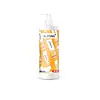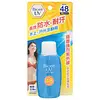What's inside
What's inside
 Key Ingredients
Key Ingredients

 Benefits
Benefits

 Concerns
Concerns

 Ingredients Side-by-side
Ingredients Side-by-side

Water
Skin ConditioningButylene Glycol
HumectantEthylhexyl Methoxycinnamate
UV AbsorberButyl Methoxydibenzoylmethane
UV AbsorberOctocrylene
UV AbsorberPhospholipids
Skin ConditioningAmmonium Acryloyldimethyltaurate/Vp Copolymer
Onsen-Sui
1,2-Hexanediol
Skin ConditioningEthylhexylglycerin
Skin ConditioningAllantoin
Skin ConditioningSodium Hyaluronate
HumectantBis-PEG/PPG-20/5 PEG/PPG-20/5 Dimethicone
EmulsifyingMethoxy PEG/PPG-25/4 Dimethicone
EmulsifyingCaprylic/Capric Triglyceride
MaskingAloe Barbadensis Leaf Juice Powder
Skin ConditioningMaltodextrin
AbsorbentHexacarboxymethyl Dipeptide-12
HumectantGlycerin
HumectantLeontopodium Alpinum Callus Culture Extract
AntioxidantXanthan Gum
EmulsifyingBiosaccharide Gum-2
Skin ConditioningPropanediol
SolventCamellia Japonica Flower Extract
EmollientPrunus Yedoensis Flower Extract
HumectantPhenoxyethanol
PreservativeChlorphenesin
AntimicrobialDisodium EDTA
Water, Butylene Glycol, Ethylhexyl Methoxycinnamate, Butyl Methoxydibenzoylmethane, Octocrylene, Phospholipids, Ammonium Acryloyldimethyltaurate/Vp Copolymer, Onsen-Sui, 1,2-Hexanediol, Ethylhexylglycerin, Allantoin, Sodium Hyaluronate, Bis-PEG/PPG-20/5 PEG/PPG-20/5 Dimethicone, Methoxy PEG/PPG-25/4 Dimethicone, Caprylic/Capric Triglyceride, Aloe Barbadensis Leaf Juice Powder, Maltodextrin, Hexacarboxymethyl Dipeptide-12, Glycerin, Leontopodium Alpinum Callus Culture Extract, Xanthan Gum, Biosaccharide Gum-2, Propanediol, Camellia Japonica Flower Extract, Prunus Yedoensis Flower Extract, Phenoxyethanol, Chlorphenesin, Disodium EDTA
Zinc Oxide 10.7%
Cosmetic ColorantEthylhexyl Methoxycinnamate 7%
UV AbsorberWater
Skin ConditioningCyclopentasiloxane
EmollientAlcohol
AntimicrobialLauryl Methacrylate/Sodium Methacrylate Crosspolymer
Dimethicone
EmollientIsopropyl Palmitate
EmollientTalc
AbrasiveGlycerin
HumectantPEG-32
HumectantMethicone
EmollientPEG-12 Dimethicone
Skin ConditioningPolysilicone-9
PEG-3 Dimethicone
Skin ConditioningParfum
MaskingBHT
AntioxidantTocopherol
AntioxidantPhenoxyethanol
PreservativeZinc Oxide 10.7%, Ethylhexyl Methoxycinnamate 7%, Water, Cyclopentasiloxane, Alcohol, Lauryl Methacrylate/Sodium Methacrylate Crosspolymer, Dimethicone, Isopropyl Palmitate, Talc, Glycerin, PEG-32, Methicone, PEG-12 Dimethicone, Polysilicone-9, PEG-3 Dimethicone, Parfum, BHT, Tocopherol, Phenoxyethanol
 Reviews
Reviews

Ingredients Explained
These ingredients are found in both products.
Ingredients higher up in an ingredient list are typically present in a larger amount.
Ethylhexyl Methoxycinnamate is an organic compound that provides UVB protection. It often goes by the more common name of octinoxate. It is created from methoxycinnamic acid and 2-ethylhexanol.
Ethylhexyl Methoxycinnamate absorbs UVB rays with wavelengths between 280-320 nm. UV absorbers protect your skin by using chemical reactions to convert UV rays into heat and energy.
UVB (290-320 nm) rays emit more energy than UVA rays. They are capable of damaging DNA, causing sunburns and are thought to be linked to skin cancer.
The state of Hawaii has banned sunscreens containing octinoxate due to its potential impact on coral reefs. More research is needed to bridge gaps in this research. The European Union allows higher levels of octinoxate in sunscreens than the US and Australia.
Ethylhexyl Methoxycinnamate is oil soluble. It is not stable and may lose efficacy when exposed to sunlight.
Learn more about Ethylhexyl MethoxycinnamateGlycerin is already naturally found in your skin. It helps moisturize and protect your skin.
A study from 2016 found glycerin to be more effective as a humectant than AHAs and hyaluronic acid.
As a humectant, it helps the skin stay hydrated by pulling moisture to your skin. The low molecular weight of glycerin allows it to pull moisture into the deeper layers of your skin.
Hydrated skin improves your skin barrier; Your skin barrier helps protect against irritants and bacteria.
Glycerin has also been found to have antimicrobial and antiviral properties. Due to these properties, glycerin is often used in wound and burn treatments.
In cosmetics, glycerin is usually derived from plants such as soybean or palm. However, it can also be sourced from animals, such as tallow or animal fat.
This ingredient is organic, colorless, odorless, and non-toxic.
Glycerin is the name for this ingredient in American English. British English uses Glycerol/Glycerine.
Learn more about GlycerinPhenoxyethanol is a preservative that has germicide, antimicrobial, and aromatic properties. Studies show that phenoxyethanol can prevent microbial growth. By itself, it has a scent that is similar to that of a rose.
It's often used in formulations along with Caprylyl Glycol to preserve the shelf life of products.
Water. It's the most common cosmetic ingredient of all. You'll usually see it at the top of ingredient lists, meaning that it makes up the largest part of the product.
So why is it so popular? Water most often acts as a solvent - this means that it helps dissolve other ingredients into the formulation.
You'll also recognize water as that liquid we all need to stay alive. If you see this, drink a glass of water. Stay hydrated!
Learn more about Water